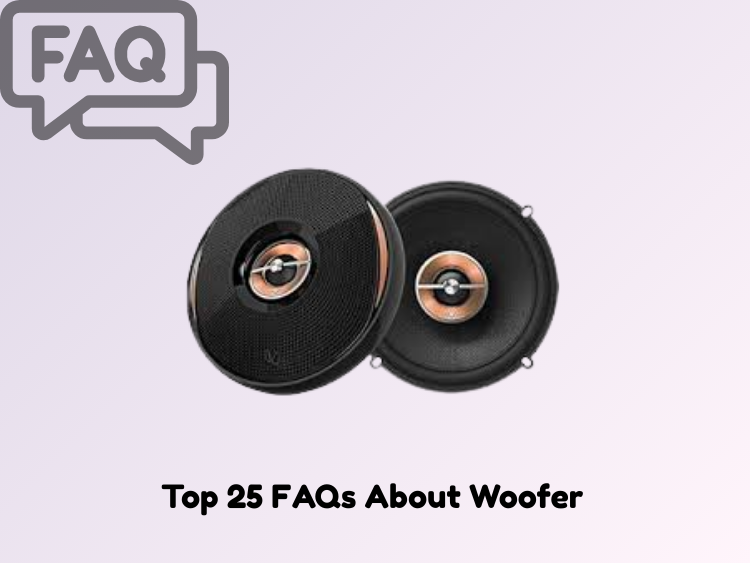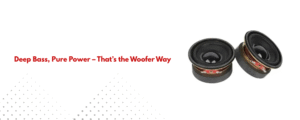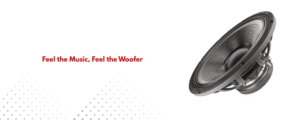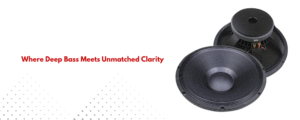The woofers are the most important part of any good sound system. There is depth, warmth, and bass that you can feel in your chest from them. If you know more about woofers, you can make better decisions when making a home theater, updating the sound system in your car, or setting up a studio. This complete guide answers the 25 most common questions people have about subwoofers.
1. What is a woofer?
A type of speaker driver called a woofer plays low-frequency sounds, usually between 40 Hz and 1000 Hz. These frequencies are what make bass, which is what gives music and sounds their depth and power.
2. What’s the difference between a woofer and a subwoofer?
While woofers can handle bass, subwoofers are specifically designed for the deepest frequencies. In many setups, a subwoofer enhances the low-end depth and rumble that woofers alone can’t fully provide, especially in home theater systems or music genres that require heavy bass.
3. What’s the point of a speaker in a house stereo?
Sound is more balanced and rich with a speaker. Not having it makes EDM, hip-hop, and action movie themes with plenty of bass seem flat and thin. It helps create a wide-range soundscape.
4. Can I ignore the subwoofer and use the woofer?
No subwoofer is needed for your speaker. The bass of a speaker alone is adequate for most casual listening. In-home movies and professional music creation, a subwoofer boosts low-end sound.
5. What are woofers made of?
Woofer cones may be made from carbon fiber, paper, plastic, and metal. Different materials vary in weight, stiffness, and sound color. While the paper is thin and fast, Kevlar lasts longer and can withstand greater power.
6. What size subwoofer should I get?
The sound quality is directly affected by the size of the Woofer. For small rooms and clear midbass, 6.5–8-inch woofers work best. For deeper, louder bass, 10–15-inch woofers are better. Your room, how you plan to use it, and your sound preferences will all affect the right size.
7. Does a bigger speaker always mean a better one?
No, not always. A bigger speaker might make the bass louder, but that doesn’t mean the sound quality is better. Amplification compatibility, crossover settings, and the shape of the box can also affect the sound quality. The speaker you choose must fit in with the rest of the system.
8. How much power does a subwoofer need?
Speaker size and usage affect power needs. Speaker RMS must be matched with an amplifier with the same RMS watts. Too much power may damage the speaker, and too little might interfere.
9. What is the best range of frequencies for a subwoofer?
Some woofers can handle frequencies lower or higher than 1000 Hz, but most can handle frequencies between 40 Hz and 1000 Hz. Going from a loudspeaker to a tweeter at around 1000 Hz and back again at 80–100 Hz is sound advice.
10. Do all sound sets need a subwoofer?
Full-range speaker systems need woofers to play sound properly. Small portable speakers may utilize digital enhancement to sound like bass, but their drivers are too small to generate low frequencies. Speakers are essential to decent sound systems.
11. Is there a difference between an inactive and an active subwoofer?
To power it, an inactive woofer needs an additional amplifier. On the other hand, an active woofer has an amplifier built right in. Most of the time, active woofers are self-contained and easy to set up. Regarding customizing and system matching, passive woofers give you more options.
12. Could I use a car subwoofer inside?
Of course, you’ll need the right power source and maybe even a new case. Car subwoofers usually work on 12V DC systems, so you’ll need an amplifier and power adapter that work with them to use them at home. Tuning correctly is also important.
13. How does housing affect how well a speaker works?
Speaker boxes greatly affect performance. Reaction level, clarity, and frequency vary. Ports are louder and have lower bass than sealed boxes. Sealed boxes provide precise bass. Woofers need enclosures of the right size and form.
14. Why is placement important for woofers?
Where you put a woofer can help or hurt the bass sound. Because of border reinforcement, putting it close to a wall or corner strengthens the bass. But if you put it in the wrong place, phase cancellation can happen and some bass sounds will be lost.
15. What is the sensitivity in woofer specs?
Sensitivity measures a speaker’s power-to-sound conversion. It’s usually reported in decibels (dB) for 1 watt at 1 metre. More awareness implies less force required to strengthen sound. A 90-dB speaker is better than an 85-dB one.
16. In what way does resistance affect us?
Impedance is the resistance a speaker offers to the electrical current coming from an amplifier. Matching the speaker’s impedance (e.g., 2, 4, or 8 ohms) with the amplifier is essential for optimal performance and to avoid damaging your equipment.
17. Can I add more than one subwoofer to a system?
Sure, but using the right wires and matching the resistance is very important. Adding more woofers can give you more bass and better sound coverage, but if you don’t wire them right, the amplifier could get too hot, or the speakers won’t work right.
18. What is a crossover, and how does it relate to woofers?
A crossover is an electronic filter that directs the right frequencies to each speaker driver. It ensures woofers only receive low frequencies, preventing distortion and ensuring clearer sound.
19. What’s the lifespan of woofers?
When taken care of properly, woofers can last very long. Heat, humidity, and too much use are all environmental factors that can shorten lives. Longevity is increased by using good materials and being careful with power.
20. Is it possible to fix a broken woofer?
Yes, most of the time. The cone, voice coil, or base are often replaced during fixes. If, on the other hand, the magnet structure is broken or the cost of fixing it gets close to the cost of a new unit, it may be better to just buy a new one.
21. Do studio woofers work differently than woofers for the home or car?
Monitor woofers are studio woofers that are made to be accurate and have a flat frequency response. Most of the time, home or car woofers are tuned to make the sound more enjoyable and full. Precision is more important than power in studio sets.
22. Who are dual voice coil (DVC) woofers?
DVC woofers contain two voice coils, giving you additional wiring and power management options. They excel at impedance matching in complex configurations.
23. Is there a different amplifier I need for my subwoofer?
It depends on whether or not your subwoofer is inactive. Active subwoofers have amps built right in. A separate amplifier ensures the woofer gets enough power to work right in passive setups without taking power away from other speakers.
24. How should I get a new subwoofer to work properly?
Playing soft music at a reasonable volume for a few hours. Usually, twenty to thirty hours is what’s needed to break in a speaker. Over time, this helps loosen the suspension and cone so that the bass sounds smoother and more accurate.
25. How can you tell if a speaker is broken?
To check if a speaker is broken, look for visible damage such as tears in the cone or surround, buzzing or clicking noises, or distortion at low settings. If these issues are present, you can swap out the speaker with a working one to confirm the issue or consult a technician for further testing.
Conclusion
Understanding woofers is key to optimizing your sound system. From selecting the right size and power to correct placement and maintenance, each factor impacts your system’s overall sound quality. Whether setting up a new system or upgrading an old one, this guide helps you make the right choices for better sound and deeper bass.00






